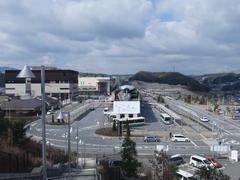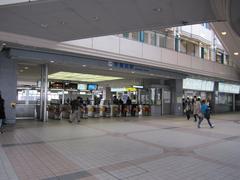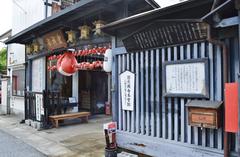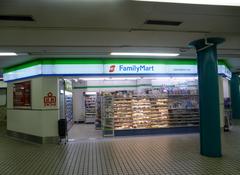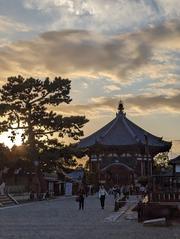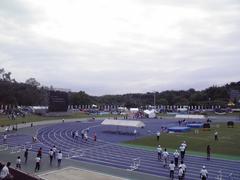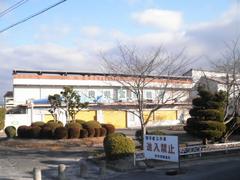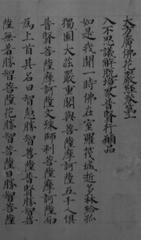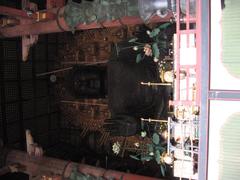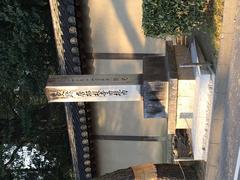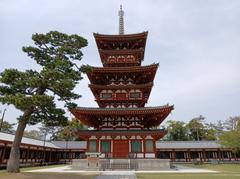Suzakumon in Nara, Japan: Visiting Hours, Tickets, and Historical Sites Guide
Date: 15/06/2025
Introduction: History and Significance of Suzakumon
Nestled in the heart of Nara, Suzakumon Gate stands as a vivid symbol of Japan’s influential Nara period (710–794 CE). During this era, Japan’s first permanent capital, Heijo-kyo, was established, inspired by Chinese city planning and governance models. Suzakumon, the grand southern entrance to Heijo Palace, was more than a gateway; it was an emblem of imperial authority, spiritual symbolism, and architectural mastery. The gate’s name derives from Suzaku, the Vermilion Bird and mythological guardian of the south in East Asian cosmology, reinforcing its role as a powerful cultural and political marker.
Though the original gate and palace fell into ruin after the capital moved in 784 CE, archaeological rediscovery and a faithful reconstruction in 1998 have revived Suzakumon’s grandeur. Today, the gate is part of the Heijo Palace Site Historical Park, recognized as a UNESCO World Heritage Site, where visitors can explore Japan’s imperial heritage amid a tranquil landscape.
This guide offers an in-depth look at Suzakumon’s history, symbolism, and architecture, alongside practical details on visiting hours, tickets, accessibility, tours, and nearby attractions. Whether you’re a history devotee or a casual traveler, use this resource to plan a memorable visit to one of Nara’s most significant landmarks. For the latest details, refer to the Heijo Palace Historical Park website and Japan Rail and Travel.
Table of Contents
- Origins and Historical Context of Heijo Palace
- Architectural Layout and Scale
- Suzakumon: The Southern Gate
- Decline, Rediscovery, and Archaeological Significance
- Reconstruction of Suzakumon
- Visiting Suzakumon: Hours, Tickets, and Accessibility
- Suzakumon in Modern Cultural Heritage
- Historical and Cultural Context of Suzakumon
- Visiting Suzakumon: Hours, Tickets, and Travel Tips
- Discover Suzakumon Gate: Visiting Hours, Tickets, and Architectural History
- Suzakumon Visiting Hours, Tickets, and Guide to Nara’s Historic Heijo Palace Site
- Summary
- References
Origins and Historical Context of Heijo Palace
Heijo Palace (Heijō-kyū, 平城宮) was established in 710 CE as the administrative and residential heart of Japan’s first true capital, Heijo-kyo. Influenced by the design of Chang’an, the Tang dynasty capital, Heijo-kyo’s layout reflected the Ritsuryo legal codes, consolidating imperial power and establishing a centralized bureaucracy (japanrailandtravel.com; kanpai-japan.com). The city flourished for 74 years, serving as the Nara period’s epicenter, before the capital was relocated in 784 (nihonmono.jp).
Architectural Layout and Scale
Heijo Palace spanned approximately 120 hectares within a 2,500-hectare city. The palace grounds were surrounded by 6-meter-high Tsukiji walls and featured 12 gates, with Suzakumon as the grand southern entrance (narashikanko.or.jp; kanpai-japan.com). The city’s main avenue, Suzaku Oji, was 74–75 meters wide, running directly north from the southern Rajomon Gate to Suzakumon—a testament to the planned grid and ceremonial grandeur (japanrailandtravel.com).
Suzakumon: The Southern Gate
Suzakumon (朱雀門), or the “Vermilion Bird Gate,” was the main entrance to the palace and a potent symbol of imperial authority. Named for Suzaku, the mythological guardian of the south, the gate marked the ceremonial boundary between city and imperial precinct (japan-trip-guide.com; evendo.com). Suzakumon hosted important state ceremonies, diplomatic receptions, and cultural gatherings (narashikanko.or.jp).
Decline, Rediscovery, and Archaeological Significance
After the capital moved, Heijo Palace fell into disuse and was repurposed for agriculture. Rediscovery efforts began in the 19th and 20th centuries, with major archaeological excavations from the 1950s onward, uncovering vital structures and artifacts that paved the way for modern reconstructions (nihonmono.jp; japan-guide.com).
Reconstruction of Suzakumon
Reconstruction of Suzakumon began in 1993, relying on archaeological evidence, ancient texts, and architectural analysis. The project used Japanese cypress, traditional techniques, and modern reinforcements, culminating in the 1998 completion by Takenaka Corporation (en.wikipedia.org; japanrailandtravel.com). The restored gate stands 20 meters tall and 25 meters wide, with vermilion pillars and a double-roofed design (narashikanko.or.jp; japan-trip-guide.com).
Visiting Suzakumon: Hours, Tickets, and Accessibility
- Visiting Hours: 9:00 AM – 5:00 PM (last entry: 4:30 PM). Confirm seasonal or holiday changes via the official site.
- Tickets: Entry to Suzakumon and the palace grounds is typically free. Some museum exhibits or reconstructed buildings may require a ticket.
- Accessibility: The site is wheelchair accessible with paved paths and ramps.
- Guided Tours: Available regularly, including audio guides in multiple languages.
- Travel Tips: Best visited in the morning or late afternoon for optimal lighting and fewer crowds.
- Nearby Attractions: Todai-ji Temple, Nara Park, and the Nara National Museum.
Suzakumon in Modern Cultural Heritage
Suzakumon and Heijo Palace Site became part of the UNESCO World Heritage “Historic Monuments of Ancient Nara” in 1998 (japanrailandtravel.com; en.wikipedia.org). The gate is illuminated at night, and the adjacent Suzakumon Hiroba Square features museums and interactive exhibits (heijo-park.jp; japan-guide.com).
Historical and Cultural Context of Suzakumon
Role in Ancient Nara
Suzakumon was the formal entrance to Heijo Palace, embodying imperial authority and cosmological symbolism. Its alignment along the city’s central axis mirrored Chinese models and was designed to channel auspicious energy into the capital (Nippon.com).
Symbolism and Urban Planning
The gate’s vermilion color, double roof, and imposing size were intended to awe visitors and underscore the emperor’s authority. The axis from Suzakumon through the palace was both a spiritual and practical spine of the city (Nippon.com).
Ceremonial and Political Functions
Suzakumon served as the setting for state rituals, diplomatic receptions, and court ceremonies, functioning as a boundary between the secular and sacred (Nippon.com).
National Identity and Modern Memory
Although the original gate was lost, its reconstruction is a statement of national identity, connecting contemporary Japan to its formative era (Nippon.com).
Cosmological and Mythological Associations
Suzaku, the Vermilion Bird, is one of four mythological guardians in East Asian cosmology—Suzakumon’s placement invokes protection and imperial legitimacy (Nippon.com).
Ritual, Festival, and Today’s Visitor Experience
Suzakumon remains a focal point for festivals and educational programs, bridging ancient traditions and modern cultural life (Nippon.com).
Practical Visitor Information
Hours and Admission
- Site Access: 24 hours for park grounds; Suzakumon Gate: 9:00 AM – 4:30 PM (last entry 4:00 PM).
- Admission: Free; special exhibitions may require tickets (Nara City Guide).
Getting There
- By Train: Kintetsu Nara Line to Heijo Palace Station, or from JR Nara Station by local bus or taxi.
- By Car: Parking available (fee applies), but public transport is recommended.
Facilities
- Visitor Centers: Multilingual support, rest areas, gift shops, and cafes (Japan RAR).
- Accessibility: Wheelchair and stroller-friendly paths, accessible restrooms.
Guided Tours
- Available via the official park website or Nara Visitor Center (Suzakumon Heijokyo).
Special Events
- Cultural festivals, reenactments, and workshops occur throughout the year. Check the event calendar for updates.
Photo Tips
- Best seasons: cherry blossom (late March–early April) and autumn foliage (late October–November).
- The plaza in front of Suzakumon offers panoramic views for photography.
Key Facts
- Reconstruction completion: 1998
- Dimensions: 25 meters wide, 20 meters tall
- UNESCO World Heritage Status: Since 1998
- Typical Hours: 9:00 AM – 4:30 PM
Frequently Asked Questions (FAQ)
Q: What are Suzakumon’s hours?
A: Park grounds: open 24 hours; Suzakumon Gate: 9:00 AM – 4:30 PM.
Q: Is admission free?
A: Yes; special exhibitions may require a ticket.
Q: Is the site accessible?
A: Yes, with wheelchair-friendly paths and facilities.
Q: Are guided tours available?
A: Yes, bookable online or at the visitor center.
Q: How do I get there?
A: Via Kintetsu Nara Line, local bus, or taxi from Nara stations.
Summary and Travel Recommendations
Suzakumon Gate is a reconstructed masterpiece that embodies Japan’s early imperial era and cultural identity. It offers a unique blend of historical education, architectural splendor, and immersive cultural experiences. With free entry, accessible facilities, and engaging events, Suzakumon is an essential stop for any visitor to Nara.
Plan your visit for spring or autumn to capture the best scenery, and check the official website for event updates. Leverage digital resources like the Audiala app for maps and audio guides. Combine your exploration with nearby attractions such as Todai-ji Temple and Nara Park for a comprehensive journey into Japan’s ancient heart.
For more, refer to the Heijo Palace Historical Park official site, Japan Rail and Travel, or Nippon.com.
References and External Links
- Discover Suzakumon Gate and Heijo Palace: Your Complete Visitor’s Guide, 2025, Japan Rail and Travel (https://japanrailandtravel.com/interests/culture-history/nara-palace-site-historical-park/)
- Suzakumon: Historical and Cultural Context, 2025, Nippon.com (https://www.nippon.com/en/japan-topics/g01157/)
- Suzakumon Gate Visiting Hours, Tickets, and Architectural History, 2025, Nara City Guide (https://www.naracity-guide.com/en/spots/150)
- Suzakumon Visiting Hours, Tickets, and Guide to Nara’s Historic Heijo Palace Site, 2025, Suzakumon Heijokyo Official Website (https://www.suzakumon-heijokyo.com/category/news/event/)
- Suzakumon Gate - Wikipedia, 2025 (https://en.wikipedia.org/wiki/Suzakumon)
- Heijo Palace Site - Japan Guide, 2025 (https://www.japan-guide.com/e/e4111.html)
- Suzakumon Gate - Evendo, 2025 (https://evendo.com/locations/japan/kinki-kansai/attraction/suzakumon-gate)
- Nara Park and Todai-ji Temple Information, 2025, Japan Rail Pass Blog (https://www.jrailpass.com/blog/nara-park)
